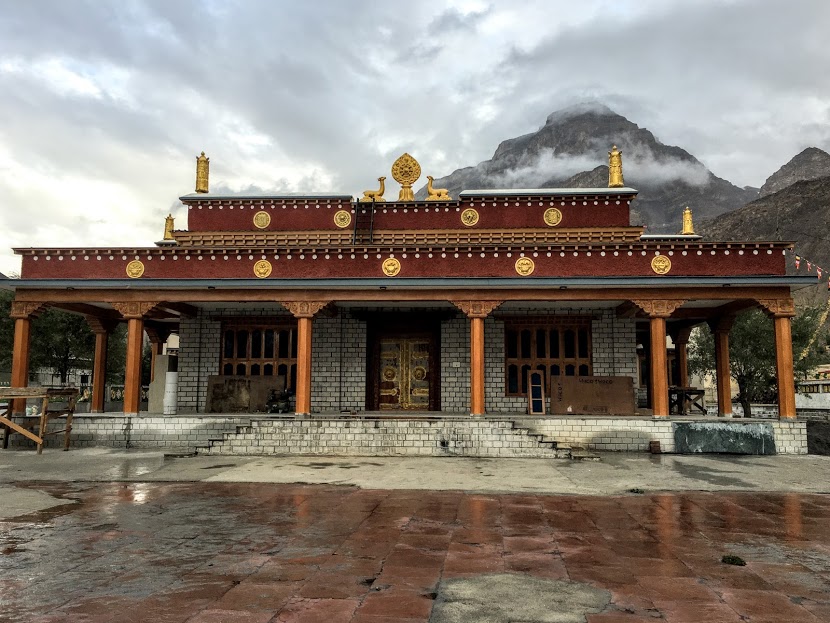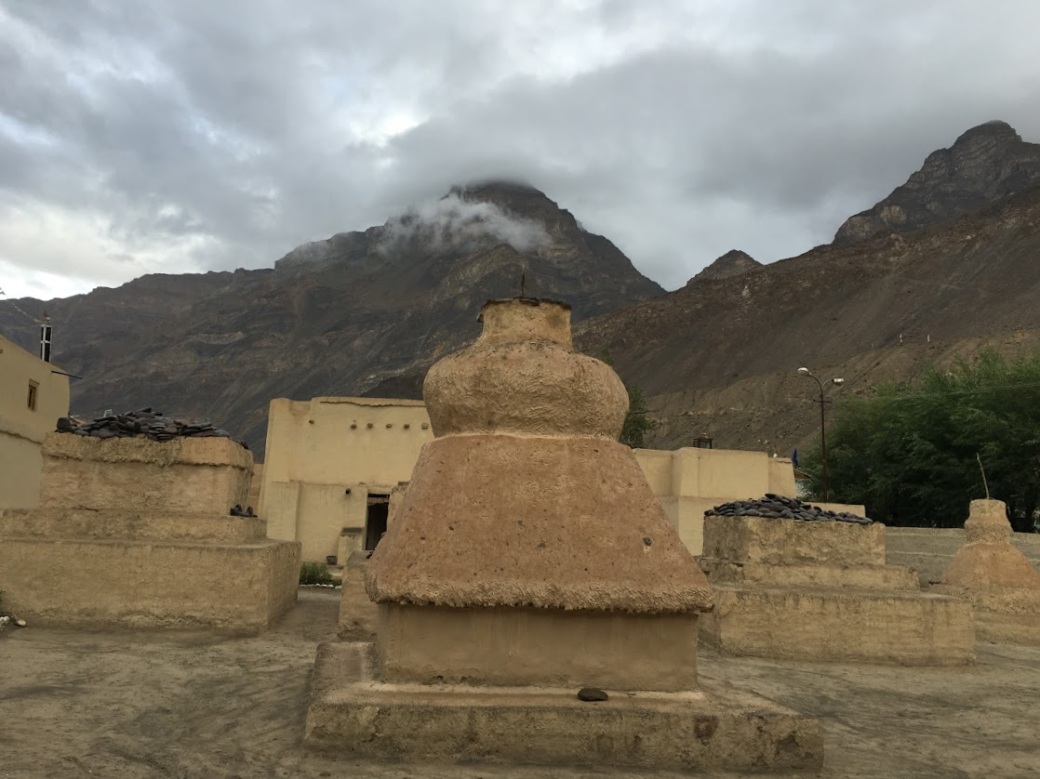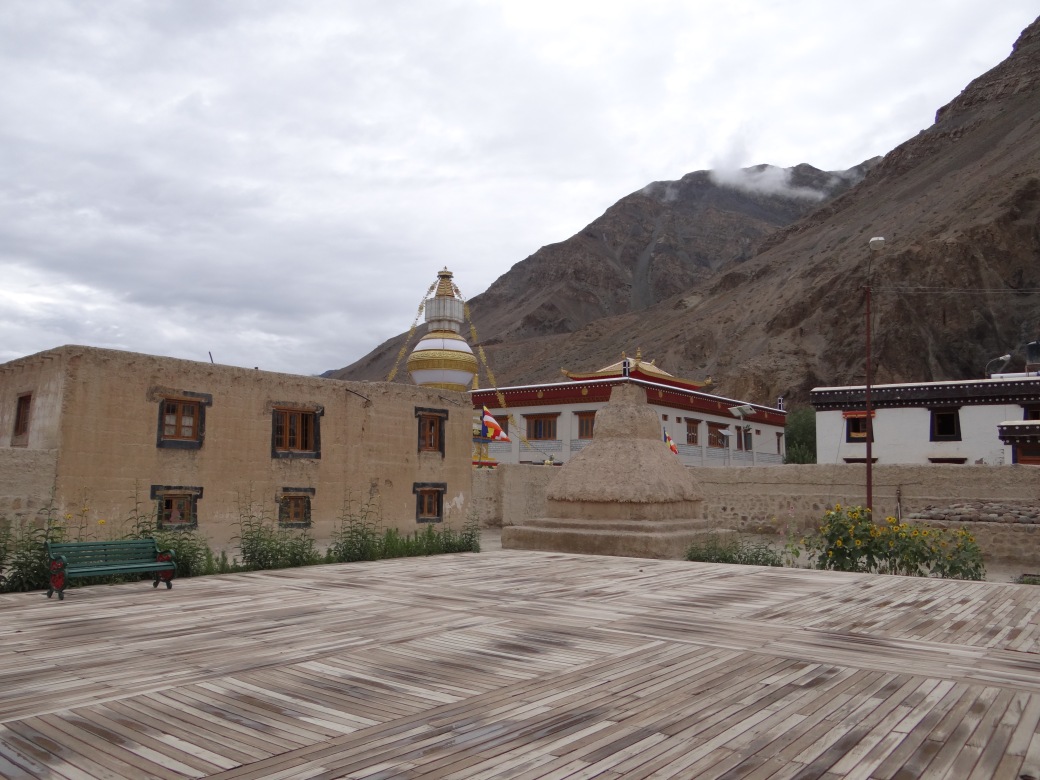After leaving Nako we took a detour to go to Gui- a small village near the Chinese border. Gui gained fame in 1975 when the Indo Tibet Border Police discovered a mummy which was later found to be a Lama. Carbon dating has estimated it to be 550 years old. Since then the Mummy Lama has become a revered local deity and this place has become a regular stop for the tourists. Each day in Spiti is turning to be different and exciting but a Himalayan Mummy was the last thing we expected to find here.
The winding road takes you to the top of a hill. The place looks isolated and barring our group, not a soul was in sight. The grand colorful monastery looks striking against the brown mountains.

The new monastery
This is going to be the new shrine for the mummy. Presently he is housed in the adjacent yellow roofed room. With mounting excitement, we walked in and came face to face with the Mummy Lama. I was expecting to see a supine figure swathed in white clothes in a tomb similar to the mummies I had seen in the Cairo Museum. The Mummy Lama is seen in the sitting posture with his chin resting on the knee in a glass case.

The Mummy Lama Sangha Tenzin
On closer look, I could make out an intact set of teeth and brittle, brownish nails. Few strands of hair are visible on the scalp. His skin looks remarkably intact. The eye sockets are empty.
No chemicals are used for the preservation and it is believed that he achieved self- mummification through deep meditation and voluntary starvation.The Buddhist ritual of self- mummification is known as Sokushinbutsu and was practiced by the monks in Japan, Thailand, and Mongolia between the 11th and 19th century. Those who achieved the difficult task are considered Living Buddhas.
One can’t help feeling awed by the ascetic monk who took this route for the ultimate salvation. They say Gui Mummy was around 45 years old. I wonder why he chose to leave the world this way. Can he look into our souls?
The new monastery is an exquisite piece of art. Wherever he is, the mystique of Mummy Lama will endure.

Other than the monastery and the mountains there is nothing much to see in the Giu village and we left for Tabo. Situated at a height of 3050m, Tabo is a major Buddhist center. We were exhausted and some of us were getting breathless and dizzy. Acute Mountain Sickness! A good sleep and Diamox was what we needed.
I woke up refreshed and set out to get a feel of the place. AMS seems to have settled. The pure cold mountain air and the pristine surroundings are highly salubrious. I will take it easy today.
Like most of the Himalayan villages, Tabo has a welcome arch, a couple of homestays, guesthouses, helipad, and friendly dogs.

Let sleeping dogs lie

The Helipad
The Tabo Monastery could be seen from far with its gleaming golden stupa and colorful flags.

Tabo Monastery- a national historic treasure

Buddhist mantra on the mountain
Once inside I felt I was in a different era. Founded in 996AD the sprawling complex is one of the oldest functioning Himalayan monasteries and is maintained by the Archeological Survey Of India. The misty mountains encircle a series of mud stupas. Buddhist chants could be heard from the main prayer hall. A monk who was hurrying for the prayers told me to come back at 8:00 when the complex will open to the public. I was in no hurry and walked around the place soaking in the overwhelming serenity and silence. Time seems to stand still……..





Tabo monastery is one of the most important Buddhist centers in India. It has a wealth of ancient scriptures, murals, frescoes, and statues. There are 9 temples, many stupas, and monk’s quarters within the complex. The main prayer hall is richly decorated from the floor to the ceiling with murals depicting the life of Buddha. We had to use a torchlight to see some of the paintings. Even a layman could make out that the rich artwork is different from what we see in the other Buddhist centers. Photography is not permitted inside to protect the precious artifacts.
Unlike most of the Himalayan monasteries which are at impossible heights atop the mountains, Tabo monastery is on flat ground ( most encouraging for the vertically challenged folks like me). Another special feature I noticed is that the mud stupas are unadorned. As I was discussing these points with my friends, the tour in charge informed that there are some caves in the mountains above the monastery. There is a well- defined trail which did not look daunting. I inhaled deeply and went up the path.

In search of the caves
In the olden days, the monks used these caves for meditation. 


Tabo seen from the hilltop.
From lofty spiritual heights, I was brought back to the present by a group of boisterous nursery kids. They were making the most of the midday break. I was delighted to see Smt.Angmo Memorial Little Star School in this remote area. So what if the classroom is small, they do have midday meals, a small play area and the kids look happy.

Adore their uniform and attitude Pc: Mangesh


The barren mountains, chilly winds, holy Tabo monastery, meditative Mummy Lama, solitary caves, and a bunch of bright kids- bliss!
Super post—and those kids are the cutest!
LikeLiked by 1 person
They added life and color to the peaceful surroundings. Thank you.
LikeLiked by 1 person
What a fantastic story of the mummy lama and excellent photos.
LikeLiked by 1 person
Interesting 🙂
LikeLiked by 1 person
And a little spooky. I was relieved to learn that the self-mummification is not practiced anymore.
LikeLike
Another super post! Thank you!
LikeLiked by 1 person
Thank you. Much appreciated.
LikeLiked by 1 person
Dear Sidran, fascinated me. Photographs are great. And also so interesting for me to read them all. Thank you, Love, nia
LikeLiked by 1 person
Teşekkür ederim arkadaşım, Nia.
LikeLiked by 1 person
Those children are adorable! They look very well cared for. And what exquisite monasteries.
LikeLiked by 1 person
Wonderful, and more!
What a trip you took! You traveled many miles to see this monastery. I know what you mean about being at high altitudes, I was up in the Andes once for at least a half year. The distance up can be longer the miles across.
And the time distance between the mummy and the children is a long distance, as well. The children look healthy and happy!!!
You have been enriched with all you have seen, and you have shared that with us. Thank you, Sidran!
LikeLiked by 1 person
I can imagine what a wonderful time you have had in the Andes.
Spiti children are very special and endearing.
Thank you very much, Resa for enriching me with your fresh perspective.
LikeLike
The pics are great!!
LikeLiked by 1 person
The credit goes to this amazing land.
Thank you.
LikeLike
The mummy is amazing Sidran and I think the children look gorgeous too.
LikeLiked by 1 person
The Mummy was a revelation! Thank you, Sue.
LikeLiked by 1 person
We’ve always wanted to visited Spiti. Your stories and pictures are incredible! Thanks for taking me there!
Cheryl
LikeLiked by 1 person
Thank you very much for coming along. Try to take time out for Spiti before it gets commercialized.
LikeLiked by 1 person
Tabo Monastery looks so peaceful in your photos. Glad your AMS did not last too long so you could enjoy the beauty of the mountains.
LikeLiked by 1 person
Your photos leave an admirable impression again! But what I wonder, why all wealth goes to monasteries, churches, mosques, temples and other religious buildings, while there is so much poverty in the world !? while I would expect that religion is a neutral thing. When I see the children here on your pictures, it’s clear that people who live a simple life are happier than we who live in luxury! I find the Mummy Lama a bit frightening! Spooky as you yourself indicated. How long will this Mummy Lama remain in this state in the current circumstances? I’m also relieved that the self-mummification is not practiced anymore.
Best regards, Heidi
LikeLiked by 1 person
I agree with your observations. I have lot of respect and admiration for the village folks who try to make the most of their life with their limited resources.
It will be interesting to see the state of the Mummy Lama in the coming years. Thank you ,Heidi.
LikeLiked by 1 person
Wow, what a fascinating place! The scenery around Tabo looks spectacular, and the kids were adorable! I’d love to visit there some day.
LikeLiked by 1 person
You must visit Spiti. You may even spot the endangered snow leopard in one of the remote villages. Cheers!
LikeLiked by 1 person
I would love to visit there, even if I don’t get to see a snow leopard!
LikeLiked by 1 person
Hi Sidran,
It’s quite interesting. I hope to visit Spiti one day. It’s one of the places in India that has historical mentions in 17-18th centuries’ Bhutan history.
LikeLiked by 1 person
Wish you and all the one you love a fantastic 2018 full of health and beautiful photowork
LikeLiked by 1 person
The best to you and yours too, Marylou.
LikeLike
Sidran, I love your posts. They are always so fun to read and interesting. They show me a completely different world than the one in which I am at home.
I especially love the photo of the two little boys.
They both look so cute in their pretty school uniform. They both look so friendly and proud and their smiles are magical.
Sidran, I look forward to reading from you again soon.
The best to you, Sidran .
Greetings from the beautiful Rhine-Highlands / Germany….
Rosie
LikeLike
Spiti Tales always surprise! The discovery of the Mummy Lama near Gui village is truly fascinating. It’s amazing how each day in Spiti unfolds with new and unexpected adventures!. Tabo Monastery truly feels like another realm!. Your blog captures the essence of this mystical destination beautifully!
LikeLiked by 1 person